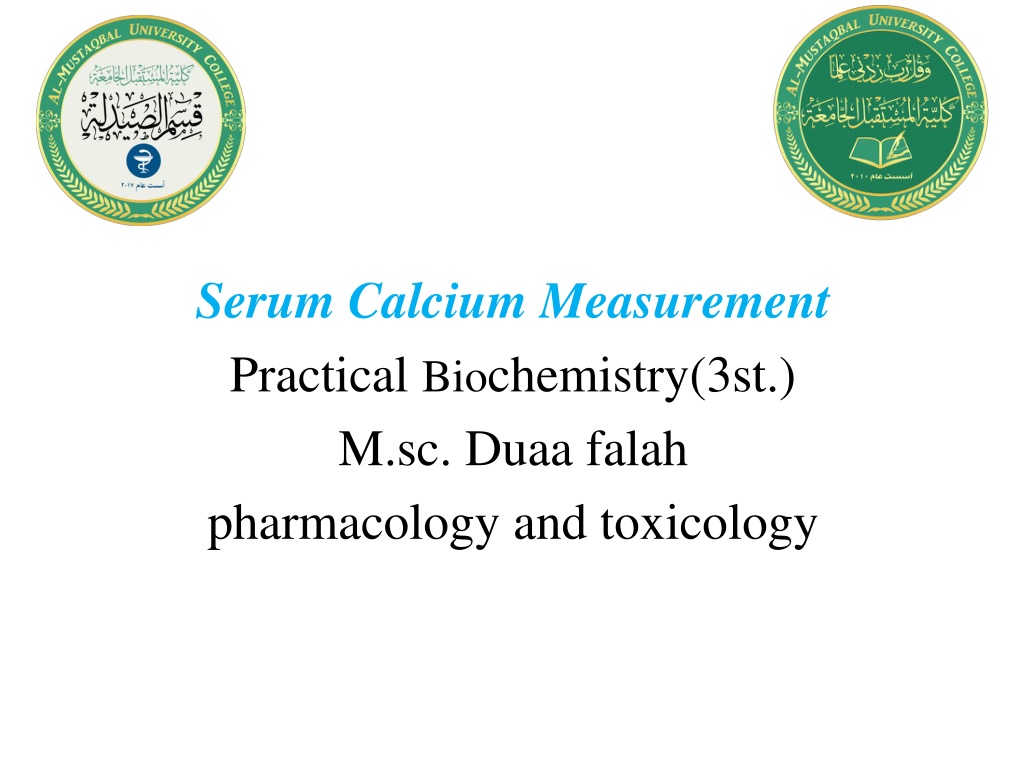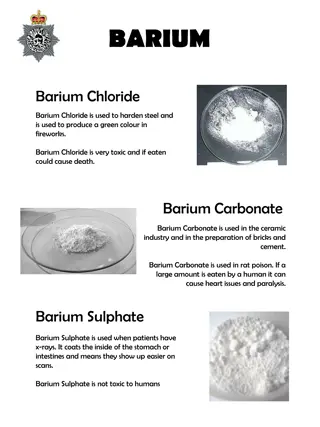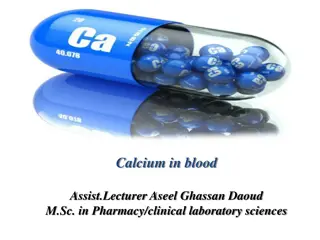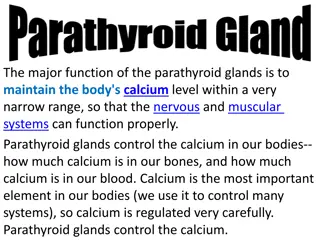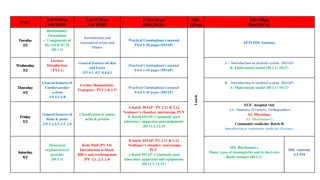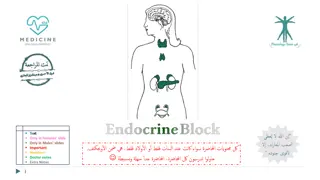Understanding Serum Calcium Measurement in Practical Biochemistry
Calcium is a crucial mineral for various bodily functions like muscle and nerve signaling, heart health, and bone formation. Serum calcium tests help screen for bone diseases and calcium disorders by measuring the amount of calcium in the blood. Two types of tests, total calcium and ionized calcium, provide different insights into calcium levels in the body. Calcium plays a key role in nerve impulse transmission and second messenger systems involving hormones like insulin and glucagon. Calmodulin, a calcium-binding protein, regulates various enzymes in the body through calcium binding. Monitoring serum calcium levels is important for overall health and detecting potential issues related to calcium regulation.
Download Presentation

Please find below an Image/Link to download the presentation.
The content on the website is provided AS IS for your information and personal use only. It may not be sold, licensed, or shared on other websites without obtaining consent from the author. Download presentation by click this link. If you encounter any issues during the download, it is possible that the publisher has removed the file from their server.
E N D
Presentation Transcript
Serum Calcium Measurement Practical Biochemistry(3st.) M.sc. Duaa falah pharmacology and toxicology
Calcium It is the most abundant and one of the most important minerals in the body. It is essential for cell signaling and the proper functioning of muscles, nerves, and the heart. Calcium is needed for blood clotting and is crucial for the formation, density, and maintenance of bones and teeth. Total body Calcium 1 1.5 kg 99% in Bones &Teeth 1% in body Fluids and tissues. found in milk and dairy products Egg yolk and Fish .
Calcium : is necessary for transmission of nerve impulses from pre-synaptic to post synaptic region. Calcium mediates secretion of Insulin, parathyroid hormone, calcitonin, vasopressin, etc. from the cells Calcium and cyclic AMP : are second messengers o different hormones . One example is glucagon. Calcium is used as second messenger in systems involving G proteins and inositol triphosphate. In myocardium: Ca++ hypercalcemia cardiac arrest is seen in systole. Caution : when calcium is administered intravenously, it should be given very slowly. prolongs systole. In
Serum calcium It is a blood test to measure the amount of calcium in the blood. Serum calcium :is usually measured to screen for or monitor bone diseases or calcium-regulation disorders (diseases of the parathyroid gland or kidneys). This test measures the amount of calcium in the blood or urine, which reflects the amount of total and ionized calcium in the body. Some calcium is lost from the body every day, filtered from the blood by the kidneys and excreted into the urine and sweat. Measurement of the amount of calcium in the urine is used to determine how much calcium the kidneys are eliminating.
measure blood calcium There are two tests to measure blood calcium: The total calcium test measures both the free and bound forms. The ionized calcium test measures only the free, metabolically active form. a) Roughly half of the calcium in the blood is "free" and is metabolically active. b) The remaining half is "bound" to proteins, primarily albumin and to a lesser extend globulins. c) also a smaller amount complexed to anions, such as phosphate, and these bound and complexed forms are metabolically inactive.
Mechanism of action of Calcium Mediated by Calmodulin, Calmodulin is a Calcium binding regulatory protein Calmodulin can bind with 4 calcium ions molwt 17000 1. Adenyl cyclase 2.??++dependent protein kinases 3. ??++ ??++ATPase 4. Glycogen synthase 5. Phospholipase C 6. Phosphorylase kinase 7. Pyruvate carboxylase
Normal calcium A normal total or ionized calcium result together with other normal laboratory results generally means calcium metabolism is normal and blood levels are being appropriately regulated. that a person's Normal serum level of calcium 8.5 to 10.5 mg /dl.
High total calcium hypercalcemia The common causes of high blood calcium are: 1. Hyperparathyroidism: 2. Cancer 3. Hyperthyroidism 4. Sarcoidosis 5. Tuberculosis 6. Prolonged immobilization 7. Excess vitamin D intake 8. Thiazide diuretics 9. Kidney transplant 10. HIV/AIDS
Low total calcium (hypocalcemia) 1. Hypoparathyroidism. 2. Inherited resistance to the effects of parathyroid hormone 3. Extreme deficiency in dietary calcium 4. Decreased levels of vitamin D 5. Magnesium deficiency 6. Increased levels of phosphorus. 7. Acute inflammation of the pancreas (pancreatitis) 8. Renal failure.
Factors affecting absorption of calcium increase the absorption rate: 1.calcitrol . 2. Parathyroid hormone. 3.acidity. 4.aminoacides ( lysine and Arginine).
decrease absorption rate: 1.Phytate 2.oxalates 3.high phosphate content. optimum ratio of calcium to phosphate content 1:2 to 2:1 allows maximum absorption. 4.free fatty acids ( FFA). ??+ FFA In soluble (Steatorrhoea) 5. Alkaline medium 6. high dietary fiber calcium soaps
Calcium can be used as a diagnostic test if a person has symptoms that suggest: Kidney stones Bone disease Neurologic disorders
